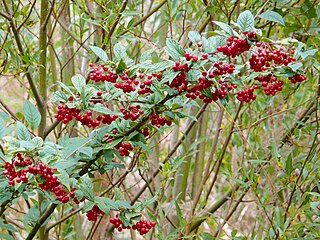
Rosaceae, the rose family, is a medium-sized family of flowering plants that includes 4,828 known species in 91 genera.

Pyracantha is a genus of large, thorny evergreen shrubs in the family Rosaceae, with common names firethorn or pyracantha. They are native to an area extending from Southwest Europe east to Southeast Asia. They resemble and are related to Cotoneaster, but have serrated leaf margins and numerous thorns.

Cotoneaster is a genus of flowering plants in the rose family, Rosaceae, native to the Palaearctic region, with a strong concentration of diversity in the genus in the mountains of southwestern China and the Himalayas. They are related to hawthorns (Crataegus), firethorns (Pyracantha), photinias (Photinia), and rowans (Sorbus).

Prunus cerasifera is a species of plum known by the common names cherry plum and myrobalan plum. It is native to Southeast Europe and Western Asia, and is naturalised in the British Isles and scattered locations in North America. Also naturalized in parts of SE Australia where it is considered to be a mildly invasive weed of bushland near urban centers.

Cotoneaster franchetii is a species of Cotoneaster native to southwestern China, in the provinces of Guizhou, Sichuan, Tibet, and Yunnan, and also in adjacent northern Myanmar and northern Thailand.

Cephalotaxus oliveri is a coniferous shrub or small tree in the family Taxaceae. It is native to China and possibly to Thailand, Laos, Vietnam and eastern India.

Cotoneaster cambricus is a species of Cotoneaster endemic to the Great Orme peninsula in north Wales. It is the only species of Cotoneaster native to the British Isles. It has never been found naturally at any other location. In the past, it was included within the widespread eastern European Cotoneaster integerrimus, but differs from that in genetic profile.

Acleris variegana, the garden rose tortricid moth or fruit tortricid, is a moth of the family Tortricidae. It has a Palearctic distribution. The moth flies from July to September mainly at night and is attracted to bright lights. The larvae feed on various trees and shrubs including rose and apple.
Silver leaf or Silverleaf may refer to:

Hydrangea radiata is an attractive, deciduous shrub up to 3 m tall in the flowering plant family Hydrangeaceae. Its natural range is limited to the southern Appalachians, where it is fairly common. Its common names—silverleaf hydrangea or snowy hydrangea—reflect its distinctive foliage which is dark green on top and silvery white below; the sharply contrasting foliar colors makes this shrub conspicuous at a distance, especially in a breeze.

Cotoneaster dammeri, the bearberry cotoneaster, is a species of flowering plant in the genus Cotoneaster, belonging to the family Rosaceae, native to central and southern China and naturalized in Europe.

Elaeagnus pungens is a species of flowering plant in the family Elaeagnaceae, known by the common names thorny olive, spiny oleaster and silverthorn; also by the family name "oleaster". It is native to Asia, including China and Japan. It is present in the southeastern United States as an introduced species, a common landscaping and ornamental plant, and sometimes an invasive species.

Quercus hypoleucoides, the silverleaf oak or the whiteleaf oak, is a North American species of oak tree or shrub. It grows in the southwestern United States and northern Mexico.

Cotoneaster lacteus, the late cotoneaster or milkflower cotoneaster, is a species of flowering plant in the genus Cotoneaster of the family Rosaceae, native to the Yunnan Province of China. It is a large evergreen shrub growing to 4 m (13 ft) tall and wide. Clusters of white flowers are followed by masses of small, globose, red fruits (pomes) in autumn. Unusually for this genus, the fruits are avoided by birds, hence garden escapes are rare, and the fruit persists on the plant throughout the winter.

Cotoneaster glaucophyllus, commonly known as glaucous cotoneaster' or bright bead cotoneaster, is a native plant of China and the Himalayas.
Bird food plants are certain trees, shrubs and herbaceous plants bearing fruits which afford food for birds. These have been discovered by observation, and by the scientific examination of the contents of birds' stomachs. By planting those species, therefore, which have been proved most desirable and that are suited to the climate and soil of the chosen location, birds can be attracted to the vicinity of dwelling houses or to any other desired spot as a copse or shrubbery, or, on the other hand, lured away from valuable orchards, since they appear to like best arid, bitter, sour or aromatic fruits, distasteful to human beings, even better than the cultivated kinds.

Cotoneaster bullatus, the hollyberry cotoneaster, is a species of shrub in the genus Cotoneaster within the rose family. Its natural range is in Western China, where it is found in a range of woodland and shrub biotopes from 900 to 3200 m above sea level.

Corokia cotoneaster is a flowering plant in the family Argophyllaceae was described by Étienne Fiacre Louis Raoul in 1846. This plant is commonly known as the wire-netting bush, korokio, or korokia-tarango. The word "Koriko" comes from the Māori language.

Cotoneaster nummularius, the nummular or coinwort cotoneaster is a species of cotoneaster. This woody shrub is native to much of Asia and south eastern Europe.

















